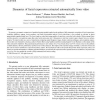Free Online Productivity Tools
i2Speak
i2Symbol
i2OCR
iTex2Img
iWeb2Print
iWeb2Shot
i2Type
iPdf2Split
iPdf2Merge
i2Bopomofo
i2Arabic
i2Style
i2Image
i2PDF
iLatex2Rtf
Sci2ools
IVC
2006
2006
Dynamics of facial expression extracted automatically from video
We present a systematic comparison of machine learning methods applied to the problem of fully automatic recognition of facial expressions, including AdaBoost, support vector machines, and linear discriminant analysis. Each video-frame is first scanned in real-time to detect approximately upright-frontal faces. The faces found are scaled into image patches of equal size, convolved with a bank of Gabor energy filters, and then passed to a recognition engine that codes facial expressions into 7 dimensions in real time: neutral, anger, disgust, fear, joy, sadness, surprise. We report results on a series of experiments comparing spatial frequency ranges, feature selection techniques, and recognition engines. Best results were obtained by selecting a subset of Gabor filters using AdaBoost and then training Support Vector Machines on the outputs of the filters selected by AdaBoost. The generalization performance to new subjects for a 7-way forced choice was 93% or more correct on two public...
Related Content
| Added | 13 Dec 2010 |
| Updated | 13 Dec 2010 |
| Type | Journal |
| Year | 2006 |
| Where | IVC |
| Authors | Gwen Littlewort, Marian Stewart Bartlett, Ian R. Fasel, Joshua Susskind, Javier R. Movellan |
Comments (0)

